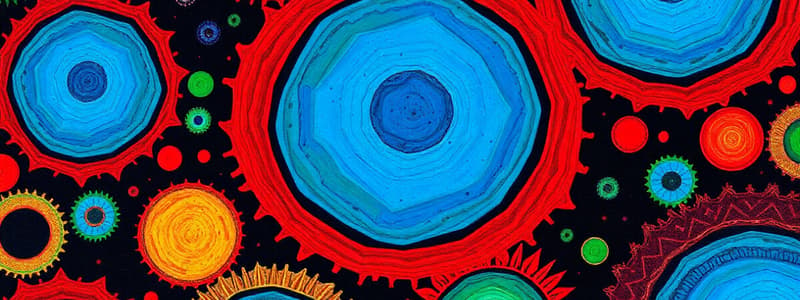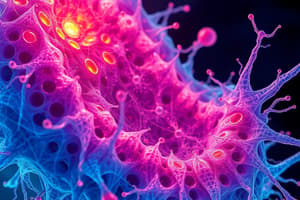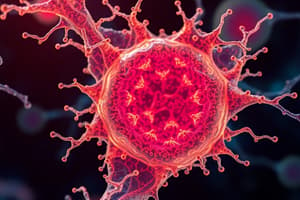Podcast
Questions and Answers
Which of the following best describes what Robert Hooke observed when examining cork under his microscope?
Which of the following best describes what Robert Hooke observed when examining cork under his microscope?
- A structure resembling a honeycomb with many little compartments. (correct)
- Irregularly shaped, solid formations.
- A continuous, fluid-filled space.
- Long, fibrous strands tightly woven together.
The observation of cells marked a minor event in the history of science.
The observation of cells marked a minor event in the history of science.
False (B)
What material did Robert Hooke examine under his microscope that led to his discovery of cells?
What material did Robert Hooke examine under his microscope that led to his discovery of cells?
cork
Robert Hooke used a self-designed __________ to make his observations.
Robert Hooke used a self-designed __________ to make his observations.
Match the person to their accomplishment:
Match the person to their accomplishment:
In what year did Robert Hooke make his initial observations of cells?
In what year did Robert Hooke make his initial observations of cells?
The term 'cell' comes from a Greek word meaning 'small container'.
The term 'cell' comes from a Greek word meaning 'small container'.
What did Hooke's observation of cells in cork lead him to conclude about living things?
What did Hooke's observation of cells in cork lead him to conclude about living things?
Cork is a substance that comes from the __________ of a tree.
Cork is a substance that comes from the __________ of a tree.
Match the object with its description
Match the object with its description
What is the primary reason the discovery of cells is considered important in the history of science?
What is the primary reason the discovery of cells is considered important in the history of science?
The use of the word 'cell' to describe the basic units of life is no longer in use in modern biology.
The use of the word 'cell' to describe the basic units of life is no longer in use in modern biology.
What did the structure of cork remind Hooke of?
What did the structure of cork remind Hooke of?
The boxes which Robert Hooke observed, he called __________.
The boxes which Robert Hooke observed, he called __________.
Match the following:
Match the following:
Robert Hooke initially believed that cells were fluid-filled containers
Robert Hooke initially believed that cells were fluid-filled containers
What is the literal meaning of the Latin word 'cell'?
What is the literal meaning of the Latin word 'cell'?
What characteristic of Hooke's microscope was crucial for his observation of cells?
What characteristic of Hooke's microscope was crucial for his observation of cells?
Living things appear to consist of __________ units.
Living things appear to consist of __________ units.
Match the following key words with their meanings:
Match the following key words with their meanings:
Flashcards
What is cork?
What is cork?
A substance that comes from the bark of a tree.
Who is Robert Hooke?
Who is Robert Hooke?
In 1665, while examining cork under a microscope, he observed tiny compartments.
What are cells?
What are cells?
Robert Hooke called the tiny compartments he saw in cork. It is a Latin word.
What are living things made of?
What are living things made of?
Signup and view all the flashcards
Study Notes
- While examining a thin slice of cork, Robert Hooke observed that the cork resembled the structure of a honeycomb, consisting of many little compartments.
- Cork is a substance that comes from the bark of a tree.
- In the year 1665, Hooke made a chance observation through a self-designed microscope.
- Robert Hooke called these boxes cells.
- Cell is a Latin word for 'a little room'.
- This was the very first time that someone had observed that living things appear to consist of separate units.
- The use of the word 'cell' to describe these units is being used till this day in biology.
Studying That Suits You
Use AI to generate personalized quizzes and flashcards to suit your learning preferences.




